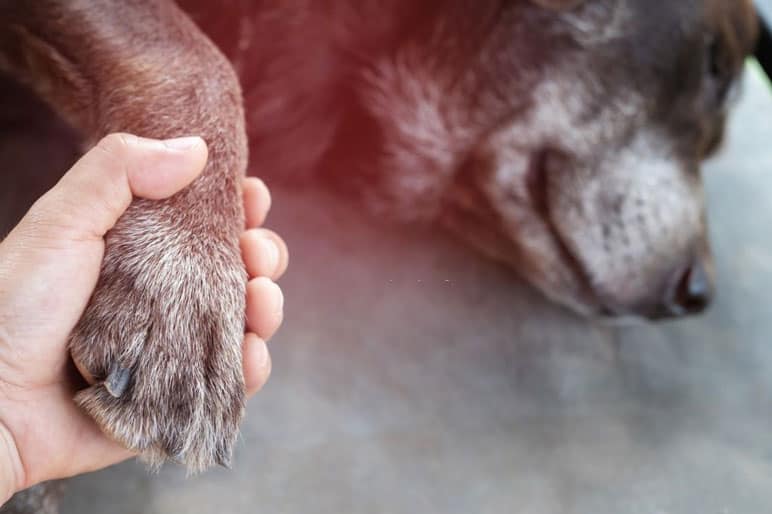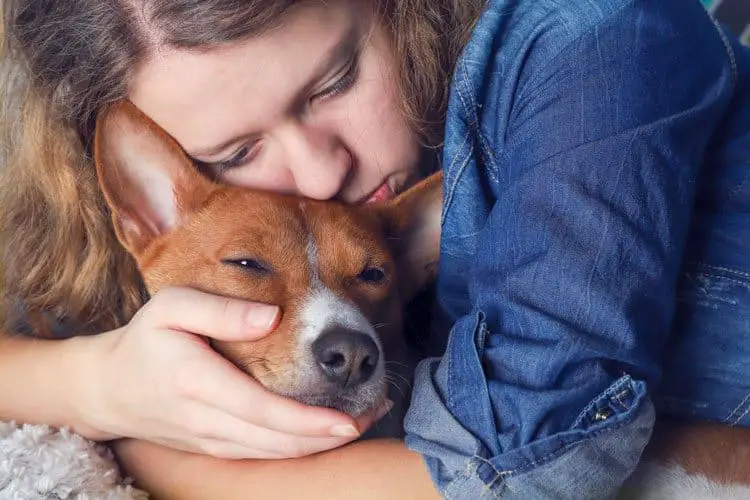Last Updated on 11/05/2020 by Veronica Jones

Few aspects of your life with your dog will be as painful as saying goodbye. It can be very hard to see the signs that the end is near, in part because you probably feel some desire to pretend that everything is fine. You owe it to your dog, your family, and yourself to recognize the warning signs that your dog is nearing the end so that everyone can prepare.
Warning signs that your dog is dying
Whether your dog is getting older or struggling with a terminal illness, it is important for you to know indications of how much time your dog has left. Every dog is different so these signs may vary by dog.
- Uncoordinated. Lack of coordination is fairly common in older dogs, but if a sudden lack of coordination comes on, especially along with other warning signs, it can be a strong indication that the time is near.
- Lack of appetite and thirst. Most dogs lose interest in food and water as their body shuts down. Even the most tempting foods will no longer appeal to them.
- Exhaustion. Your dog may seem to be tired all of the time. Even when they first wake up, they may not have much friskiness.
- Accidents. Your older pet may be unable to control their bowels or urination and they may not be able to get up to go outside easily or at all.
- Confusion. Many older dogs develop a form of dementia. Sudden onset or worsening of symptoms may show that a dog is no longer very present and may be nearing death.
- Discomfort. As dogs near the end, they may be unwilling to settle down. They alternate between pacing as if looking for something and sleeping but never really seem very comfortable.
- Indifference. Your dog won’t care about things that mattered to them before. They may still want to be near you, but they won’t care about playing, walks, or treats.
- Behavior changes. Some dogs want to be near you or other family members all of the time as the end nears. Other dogs want to be alone and may even try to wander away from home.
- Respiration changes. Dogs may breathe very slowly while they sleep or at rest but breathe rapidly during times that they are awake. Fast panting may indicate pain.
Time frames
Some dogs will experience these signs much faster than others. Some dogs will stay in one stage or another for a long time. That said, here are some things to look for along with likely time frames.
Several months to several weeks before your dog passes
- Losing weight and various gastrointestinal changes like eating and drinking less, diarrhea, vomiting, loose stools, etc. Dogs may also be more prone to dehydration as a consequence of drinking less.
- Dullness in eyes, coat, and activity. Dogs may be less interested in grooming themselves and their coats will lose shine. Eyes seem less bright and dogs are less responsive and involved in their environment.
Several weeks before passing
- Rapid weight loss and eating much less. Dogs may suddenly refuse all but the most desirable foods and eat those with less enthusiasm.
- Breathing changes. Your dog may pant more when awake and breathe very shallowly while they’re sleeping. You may find yourself checking to see if your dog is breathing.
- Disinterest. Your dog may be uninterested in things that once gave them pleasure, like a walk or trip outside, a favorite toy, etc.
- Behavior changes. Your dog may become clingy with you, wanting to be with you all of the time, or they may begin to isolate themselves and seek out places to hide more often.
A few days before your dog passes
- Complete disinterest in eating. Your dog may stop passing stool or the stool may be an unusual texture or color. Your dog may nibble at the choicest treats but will not eat hardly anything.
- Lack of interest. Disinterest will become complete indifference as your dog prepares to pass. They may seem to have a distant look and have a hard time focusing on you.
- Various sudden changes. Some people notice a difference in the way their dog rests, like an unusual stillness. Some people even find that their dogs smell different.
How to help your dog through it
Saying goodbye to your dog will be one of the worst times of your life. It is terrible to lose your beloved companion and it is painful to watch your dog go through the confusion of dying. It can be hard to maintain any kind of control during this time, but for your dog’s sake, it is best to try.

Control your emotions
Dogs don’t understand death as we do, and many dogs don’t seem particularly stressed by the process of death. However, if you are distraught and stressed while your dog is dying, they may also feel stressed and anxious.
Try to remember the good times that you’ve had with your dog and not focus on how hard it is to lose them. Maintain as positive an attitude as you can while you are with your dog.
If you need to let out your grief go somewhere else for a bit to grieve while another family member or friend stays with your dog.
Control the space
Your dog may wander around and be very uncoordinated as their end draws near, so it is important that you have control over the space that they are in so that they are comfortable and don’t hurt themselves. Make sure sharp edges and tripping hazards are removed. Make the space as safe and comfortable for your dog as possible.
Dogs often pick strange places to settle down. If possible, it may be best to let them choose wherever they like, but if you need them to settle somewhere else, try to choose somewhere as similar to their initial choice as possible. Don’t let family members, guests, other pets, or kids go in and out of the space without your supervision.
Dogs can behave unpredictably towards the end of their life and they may just want to be left alone. Try to only allow people and pets to interact with your dog when your dog is seeking out attention.
Be mindful
It can be so hard to acknowledge that your dog is progressing towards the end of their lives. You may hope that they are just going through a bad spell that they’ll come out of. It is a good idea to keep a simple journal of your dog’s behavior, how much they’re eating and drinking, etc. so that you can keep track of the rate at which their condition is worsening.
Preparing other pets
It is very hard for other pets to experience the loss of a friend. Depending on how closely bonded your pets are, your other pets may barely react to your dog’s passing or they may be distraught.
It’s important to remember to pay attention to the needs of your other pets as well as the dog who is dying. As much as possible, it’s a good idea to maintain routines like walks, eating times, etc.
Just as it is important to maintain a positive attitude with your dog who is dying, it is essential to keep a strong, positive attitude with other pets. Your other pets need to know that things will be ok for them, although this is a hard and stressful time.
Natural death
Dogs who die natural deaths sometimes fall asleep and never wake up. Sometimes they tremble or have seizure activity as they pass. Here are some ways that you can tell that your dog has passed.
- Complete relaxation. When your dog passes, all tension will leave their bodies. Even if they were relaxed before, this is a very different sort of still relaxation.
- Breathing stops. Your dog’s body will seem to become thinner as the air leaves their body. There will be no more breath coming from them.
- Unresponsive. The eyes may be open or closed, but the pupils will not dilate with changes in light.
- No heartbeat. You won’t be able to detect a heartbeat, either by listening with your ears alone or with a stethoscope.
- Bladder or bowels emptying. Many dogs won’t have much in their bladder or bowels by the time that they pass, but what is there is likely to expel when they pass.
Euthanasia
Many people decide that their dog’s passage should be aided by euthanasia. Natural death can stretch on sometimes and dogs may begin to suffer. If you think that your dog might be in pain or that they are ready to move on but their body isn’t quite there yet, euthanasia is a humane decision.
Many veterinarians perform home euthanasia. The vet will arrange to come to your home. They should prepare you for what is going to happen and give you time to grieve with your dog before and during the process. The veterinarian will place a waterproof blanket under your dog’s blankets so that when your dog expels their bowels or bladder, the mess will be contained.
Your dog will first be injected with a sedative to relax them and prevent them from experiencing any pain. Then, your dog will be injected with a euthanasia drug that rapidly stops brain function.
It is normal for the legs or head to move, or even for your dog to vocalize as their body experiences final reflexes. Your veterinarian may bring your dog’s body with them to the clinic to be picked up for cremation, or you may decide to bury your dog yourself.

1 thought on “Important Warning Signs That Your Dog Is Dying and How to Prepare”